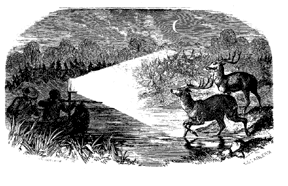
|
Volume 16, Issue 50 - December 11 - December 17, 2008
|
|
Columns |
|
|
Walking in Meshach’s Footsteps
For 53 years, I’ve hunted meat and memories
The wild buck is a most
beautiful animal.
–Meshach Browning in
Forty-Four years of the Life of a Hunter: 1859
I couldn’t agree more with Maryland’s legendary outdoorsman. The beautiful wild whitetail buck has drawn me like a magnet to the mountains of frigid Western Maryland for yet another year in hopes of venison for the pot. But it matters not much whether I score with my rifle.
I am roaming the very same glades and mountains that Meshach Browning tromped with musket, powder and ball well more than 100 years before I arrived in Maryland. Being more than a bit of a romantic, at every step of my hunts I fantasize whether I am crossing his long-gone tracks.
Many a path he beat out here when he lived off the land and settlements were few and far between, wild game was abundant and the word condo had never been spoken. Garrett County continues to change at a whirlwind pace, but get far enough from its hub at Deep Creek Lake and there remain some remnants of the primitive wilderness of Meshach’s days.
Fifty-three deer seasons have passed since I first arrived in Maryland, and I can count on two fingers the years I have failed to make it here for the ritual of the modern firearms buck season with the mountain boys fortunate enough to live here year-round. I come at other times of the year for cross-country skiing, grouse and turkey hunting and trout fishing in the high country streams and, of course, Deep Creek Lake, the biggest of all Maryland’s inland waters.
Were that man-made impoundment around in Meshach’s days, he could have ice-fished it for a more varied menu than the deer, bear and wild turkey at his Garrett County cabin in winter. At least once a year, when departing the big lake for home, I stop at the old cemetery, a few miles to the north of the lake, where Meshach rests, to pay tribute to the hunter who documented 44 years of what was in his time Maryland’s frontier.
We would not have known what it was like. Had we been told by other than one who had lived it, we would have found it hard to believe that wolves, panthers, wildcats, catamounts and the likes hunted where city folks now summer in fancy colonies overlooking the lake and complain of nuisance bears that have become tame enough to feed on their garbage or the seeds in their bird feeders.
I’ve mentioned Meshach Browning a few times in this space. There were vague recollections of tales of his exploits: word of mouth stuff, much exaggeration, few details. Was he for real? readers asked.
Meshach’s Life List
In the introduction to Meshach’s Forty Four Years of the life of a Hunter, his friend Edward Stabler wrote that Meshach killed from 1,800 to 2,000 deer. That’s a figure all Maryland hunters combined in a week’s season couldn’t top until 1955. The family, wife and four children, living in a 10-by-12-foot cabin, ate much venison. Some was sold, as were the hides of deer, bear, wolves and panthers.
Bears? He took 300 to 400 of them, about 50 panthers and catamounts, scores of wolves and wildcats, many turkeys and trout from the streams. The hunting was via ball and powder, not repeating rifles, and reloading was neither fast nor easy; at times there wasn’t the chance to prepare for a needed second shot. More than a few times, it was a one-on-one confrontation, as when he got mixed up with a big and angry bear and administered the coups de grace with his hunting knife in a desperate wrestling match.
He played hide ’n’ seek with a panther of 11 foot three inches tip of nose to tip of tail in a thick laurel swamp at Meadow Mountain. A deer almost drowned him as he tried to retrieve it from waters. He got lost in frigid temperatures and survived only by the cover and warmth of the carcasses of big game he had just killed.
They all happened in nooks I’ve hunted and still hunt: Green Glades, Meadow Mountain, Deep Creek, Roman Nose, shores of the Youghiogheny, Savage Mountain and such. It was probably at the Yough that Meshach fashioned from his canoe a rig that via candles and torchlight committed what today is considered the most foul of all poaching techniques: jacklighting deer (see accompanying illustration). If the deer or other game wasn’t near water, a salt lick was placed beneath a tree. From a limb, Meshach would shoot his dinner via light from a candle tied to a pole.
The deep forests, swamps, glades and mountains out here, much of it preserved as state forests, ring with memories of when mountain men like Meshach Browning lived and prospered from land untainted by humans. I find it a privilege hunting these same grounds with their storied pasts. That is why the highlights of my chase of deer are here where chances of success are much slimmer than in Central Maryland and the Eastern Shore. I find nostalgia more appetizing than a backstrap of venison. Enough said.
